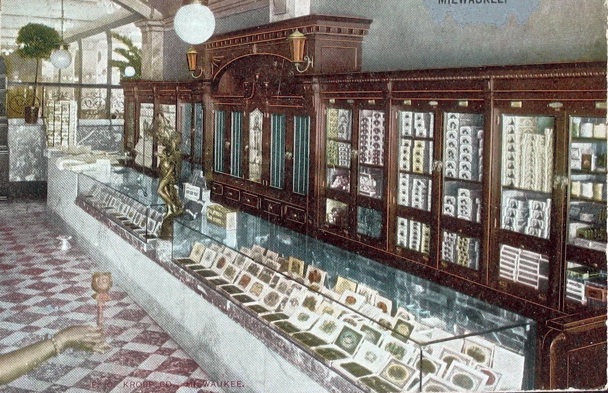HIGH-PRICED CIGARS
The Weeds that Bring Fancy Prices,
and the Men who Buy Them.
A young man with neatly brushed hair and a light-blue necktie stood behind a cigar stand in a fashionable and well-known cafe up town the other day. It was very dull, as the Wall street men had not begun to drop in on their way home, and the loungers had wandered out on Broadway. In the case were cigars of every variety, from the ordinary ten-cent kind to wicked and powerful looking things ten inches long. This would not have been out of the ordinary. Everywhere food was served you could also buy cigars. This remained true until the 1940s.
“The law compels us to sell the cigars out of the boxes just as we buy them.” said the clerk, feeling for the sprouts of a budding moustache [sic]. “Formerly we had a set of beautifully polished rosewood trays, but we had to throw them aside.” That law was passed in 1868; it prohibited removing cigars from boxes except to sell them; refilling empty boxes with cigars from a different box was also forbidden. These were measures to prevent tax fraud that the industry brought on itself by committing a lot of very clever tax fraud.
Every box bore a small illuminated card on which was the retail price of the cigars. These cards were 10, 15, 20, 25, 30, 45, 50, and 80 cents, and two boxes were marked $1 and $1.50 apiece respectively. There were no cigars missing from the 45-cent box, though the 50-cent one was almost empty. The clerk said that if a man bought a high-priced cigar he preferred to pay the extra five cents, and get one for half a dollar rather than forty-five cents.
“At one time we thought it would add tone to the stand,” said the clerk, “to take off all price tags, but we found it wouldn't work. Customers cannot remember the names of cigars and resort to the figures for identification. That’s why industry history is filled with look-alike designs and sound-alike brand names. Besides, the ignorance of the prices often led to awkward situations. A man would stop at the stand on his way out with some friends and say”
“Gimme some cigars.”
“What kind?”
“Well, he would look about blindly for a time and finally order half a dozen of the kind that struck his fancy. If they happened to be the eighty-cent or dollar variety, he would pay the bill, but he would never buy of us again. So we put the tags back again.” I don’t remember ever visiting a 1950s retail outlet that didn’t have every box of cigars clearly marked. Since selling price was determined by the amount of taxes paid, nearly all American manufacturers printed the price on the label. Cubans did not, and their higher prices demanded being their being marked by retailers, often boldly.
“Do you sell many cigars at a dollar apiece?”
“The sale is very uneven. Sometimes the box will lie for weeks untouched, and then again there will be a sudden rush on them. I have smoked a dollar-and-a-half cigar,” said the clerk with a proud smile.
“Did you enjoy it?”
“Not for a cent. It was given to me one night by a prominent broker who had just made a big turn on the street and felt generous. He bought fifty of them, and handed them to whoever he met. I took mine home, and after dinner on Sunday I invited some friends in and I smoked it. Well, I s’pose I’m not up in extra fine cigars, for I didn’t get a bit of comfort out of that one. It was so strong that it parched my throat and left an unpleasant taste.”
“Don’t you consider $1 and $1.50 apiece purely fancy prices?”
“Well, I don’t know but they are a bit spectacular. A cigar can be so good and no better. On the highest-priced wholesale list the most expensive cigar is the Para in Nobleza, which sells to the trade for $413 a thousand. This is a little over forty-one cents apiece. They are retailed at any price above fifty cents. We can’t sell them at fifty because singularly enough, everybody who buys a fifty-cent cigar expects three for a dollar.”
“What men buy very high-priced cigars?”
“Nearly all of our customers buy as high as thirty cents, and we sell hundreds of fifty-cent cigars. The purchasers of the very expensive ones are a few men whom I could count off on my fingers. Thy buy them because they are so very expensive, and not because they like the flavor. I suppose that if we had cigars at $3 apiece, there would be purchasers.” Remember that this is in an upscale restaurant in the Wall Street district of New York City. Smaller, less fancy restaurants would cap prices around 30¢ and those catering to working class folks would probably offer cigars at no more than a dime or 15¢ with prices as low as 2/5¢.
NCHM Home Important Events
Cigar History


